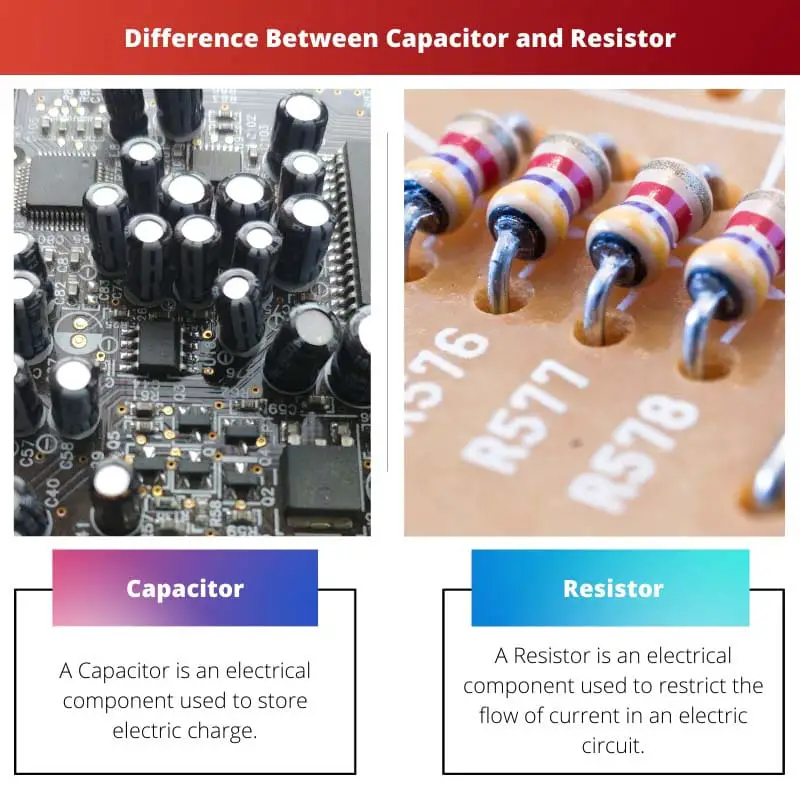Capacitors and Resistors are two critical passive components of an electric circuit. Both play different roles in determining how the circuit behaves and are connected through conductive wires through which electricity pass.
Key Takeaways
- A capacitor is an electronic component that stores and releases electrical energy, characterized by its ability to pass alternating current (AC) signals while blocking direct current (DC) signals.
- A resistor is an electronic component that opposes the flow of electric current, helping to control voltage and current levels in a circuit.
- Both capacitors and resistors are fundamental components in electronic circuits, but they perform different functions, with capacitors managing energy storage and resistors controlling current flow.
Capacitor vs Resistor
Capacitor is an electronic device used to store electrical energy in the form of charges, a resistor is an electronic device used to resist or block the current flow in a circuit. The capacitors can store an electrical account for a short period while the resistors block the wind in a course.

When a capacitor is connected to a circuit, DC Circuit can’t flow through the course because of its insulating layer and is stored in the form of charge across the conductive wires.
On the other hand, when a Resistor is connected to a circuit, it absorbs the electric current and dissipates the energy in the form of heat.
Comparison Table
| Parameter of Comparison | Capacitor | Resistor |
|---|---|---|
| What? | A Capacitor is an electrical component used to store electric charge. | A Resistor is an electrical component that restricts the current flow in an electric circuit. It creates friction like a force that blocks the current. |
| Effect on Circuit | A capacitor stores electrical energy through charges across the conductive plate when added. | When added, a Resistor absorbs electrical energy and dissipates it as heat. |
| Use | Capacitors are used for filtering, smoothening, coupling different sections of the circuit, and limiting high voltage transient across the circuit. | Resistors reduce current flow, divide voltages, terminate transmission lines, and adjust the signal level. |
| Power loss | Capacitor does not make any electrical power loss. | The resistor creates power loss and creates heat. |
| Dependence on Frequency | The opposition to the flow of current depends on the applied frequency. | The opposition to the current flow does not depend on the applied frequency. |
| Units | Capacitance is measured in farad. | Resistance is measured in ohm. |
| Formula | C=Q/V | R=V/I |
| Scope | It can block only DC Current. | It can block both DC and AC Currents. |
What is Capacitor?
A capacitor is a passive component of an electric circuit that can store energy in the form of an electrical charge producing potential differences across its plate.
Many varied sizes of capacitors are available, from tiny ones used in resonance circuits to large capacitors used in power factor correction.
It consists of two (or more) parallel metal plates which do not touch each other but are electrically spaced separately (by air or by some other good like mica, plastic, etc.). This insulating layer between conductive plates is called a Dielectric.
Because of an insulating layer, DC current cannot flow through the capacitor; instead, a voltage is developed around the plates in the form of an electric charge.
On the other hand, when capacitors are connected to the AC circuit, the current passes through the capacitor with little resistance.
It makes the electric charge by making use of external voltage. Therefore, it only stores electrons to store energy and emits the charges later whenever required.
A capacitor can be classified as Fixed Capacitors, whose capacitance shows a fixed value and does not adjust behaviour and Variable Capacitor. Such Capacitors offer adjustable behaviour to circuit operations.
The formula to find capacitance is C=Q/V. Capacitance (in farad) equals Charge (in coulomb) divided by Voltage (in volts).

What is Resistor?
A Resistor is another basic component of the electrical circuit. It restricts and blocks the flow of electric current through a circuit. The energy measures the Resistance of a Resistor. It can dissipate in the electric circuit.
It contributes to limiting the capacitor’s charging rate, adjusting the RF circuits’ frequency response, and acting as a voltage divider for the circuit.
When a resistor is connected to a circuit, it controls the flow of charge by absorbing the electrical amount and dissipating it in heat.
Two basic measurements related to resistors are resistance (measured in ohm) and power to dissipate energy (measured in watts).
A Resistor can be classified as a Fixed Resistor, in which the value of resistance is fixed and a Variable Resistor, which offers adjustable resistance when connected to any circuit.
The formula to calculate resistance is R=V/I. Resistance (in ohms) equals Voltage (in volts) divided by Current (in amperes).

Main Differences Between Capacitor and Resistor
- A capacitor is an electronic component that stores electric energy in charge. At the same time, the Resistor is an electronic component that limits or regulates or blocks current in the circuit.
- A capacitor is used to keep the positive and negative charges separate, while the Resistor is used to control the flow of current to other components of the circuit.
- A capacitor stores the electrical current as charges across the conductive wires while the Resistor absorbs electrical energy and dissipates it in heat.
- A capacitor does not lead to any power loss, while Resistor does.
- Capacitance is measured in farads by dividing charge by the voltage, while Resistance is measured in ohm by dividing voltage by the current. lewd




